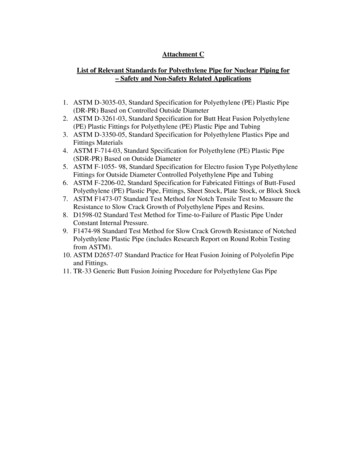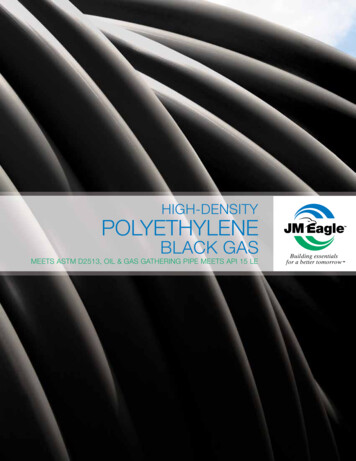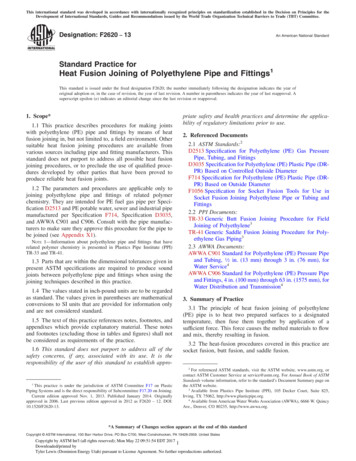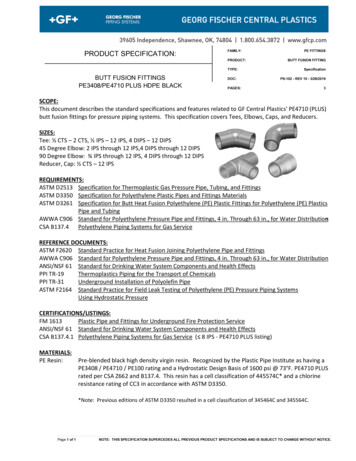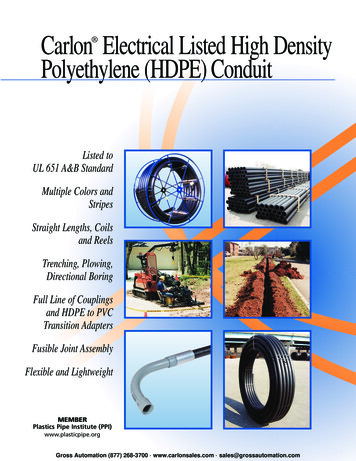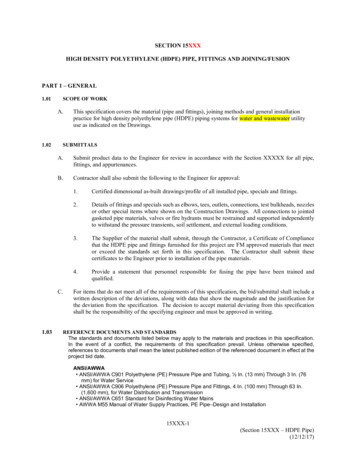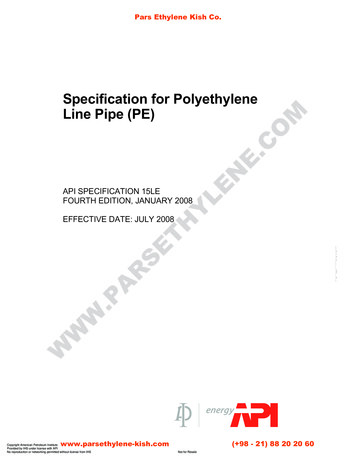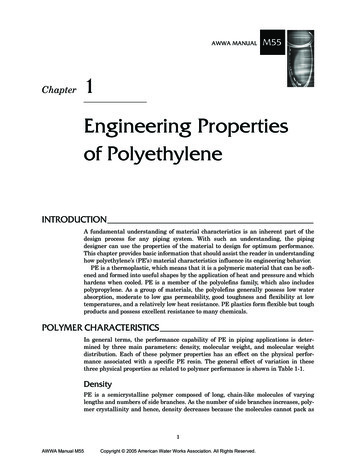
Transcription
AWWA MANUALChapterM551Engineering Propertiesof PolyethyleneINTRODUCTIONA fundamental understanding of material characteristics is an inherent part of thedesign process for any piping system. With such an understanding, the pipingdesigner can use the properties of the material to design for optimum performance.This chapter provides basic information that should assist the reader in understandinghow polyethylene’s (PE’s) material characteristics influence its engineering behavior.PE is a thermoplastic, which means that it is a polymeric material that can be softened and formed into useful shapes by the application of heat and pressure and whichhardens when cooled. PE is a member of the polyolefins family, which also includespolypropylene. As a group of materials, the polyolefins generally possess low waterabsorption, moderate to low gas permeability, good toughness and flexibility at lowtemperatures, and a relatively low heat resistance. PE plastics form flexible but toughproducts and possess excellent resistance to many chemicals.POLYMER CHARACTERISTICSIn general terms, the performance capability of PE in piping applications is determined by three main parameters: density, molecular weight, and molecular weightdistribution. Each of these polymer properties has an effect on the physical performance associated with a specific PE resin. The general effect of variation in thesethree physical properties as related to polymer performance is shown in Table 1-1.DensityPE is a semicrystalline polymer composed of long, chain-like molecules of varyinglengths and numbers of side branches. As the number of side branches increases, polymer crystallinity and hence, density decreases because the molecules cannot pack as1AWWA Manual M55Copyright 2005 American Water Works Association. All Rights Reserved.
2PE PIPE—DESIGN AND INSTALLATIONTable 1-1Effects of density, molecular weight, and molecular weight distributionAs Density IncreasesAs Molecular WeightIncreasesAs Molecular WeightDistribution reases slightlyDecreasesImpact strengthDecreasesIncreasesDecreasesLow temperature brittlenessIncreasesDecreasesDecreasesAbrasion creases slightly—PropertyTensileSoftening pointIncreases—IncreasesStress crack ecreasesIncreases slightly—Chemical esMelt strengthclosely together. Density affects many of the physical properties associated with theperformance of the finished pipe. Properties such as stress crack resistance, tensilestrength, and stiffness are all affected by the base resin density of the polymer asshown in Table 1-1.Base resin density refers to the density of the natural PE that has not been compounded with additives and/or colorants. Within this range, the materials are generically referred to as either medium or high density in nature. PE pipe resins with abase resin density in the range of 0.935 to 0.941 grams per cubic centimeter (g/cc) arereferred to as medium density PE. PE pipe base resins in the range of 0.941 to 0.945 g/ccare commonly referred to as high-density polyethylenes (HDPEs). Industry practicehas shown that base resin (unpigmented) densities in the range of 0.936 to 0.945 g/ccoffer a highly beneficial combination of performance properties for the majority of piping applications.The addition of carbon black to the base PE resin does have an impact on the compounded density of the material. The addition of 2 to 2.5 percent carbon black raisesthe compounded material density on the order of 0.009–0.011 g/cc. The variability inthe actual percentage of carbon black incorporated can have a moderate affect on comparative density values. As a result, industry practice as established by ASTM standard is to provide comparative values on the base resin density as this is a betterindicator of the polymer crystallinity.Molecular WeightPE resins are composed of a number of molecular chains of varying lengths. As aresult, the molecular weight of the resin is the average of the weight of each of thesechains. The average weight may be determined using sophisticated scientific techniques, such as gel permeation chromatography or size-exclusion chromatography. ForPE of a given density, the effect of increasing molecular weight on physical propertiesis shown in Table 1-1.A very rough indicator of the molecular weight of a polymer may be obtained usingthe melt index technique of analysis as described in ASTM D12381. The melt index technique is an inexpensive means of comparing, in a relative manner, the molecular weightof PEs having similar structure. Resins with a relatively low average molecularAWWA Manual M55Copyright 2005 American Water Works Association. All Rights Reserved.
ENGINEERING PROPERTIES OF POLYETHYLENE3weight will have a comparatively high melt index. Conversely, resins with a relativelyhigh molecular weight will yield a lower melt index. From this relationship, we canassociate changes in physical properties (as shown in Table 1-1) with changes in meltindex of the material. It is important not to use melt index alone as a definitive indicatorof molecular weight because variations in polymer structure can affect both molecularweight and melt index.Molecular Weight DistributionMolecular weight distribution (MWD) refers to the statistical grouping of the individual molecular chains within a PE resin. Resins made up of molecules that vary considerably in molecular weight are considered to have a broad MWD. When most of themolecules are nearly the same length, the MWD is considered narrow. The effect ofbroadening the MWD of a PE resin having a given density and molecular weight isshown in Table 1-1.Recent AdvancesIt should be noted that recent advances in polymer technology have led to the development and introduction of even higher density resins for use in piping applications.These new materials that have base resin densities as high as 0.952 g/cc in combination with higher molecular weight and bimodal molecular weight distribution are generally recognized as offering higher levels of technical performance under ISOstandards for PE piping that are common outside of North America. These higher levels of technical performance are not yet recognized within the North American standards system.MECHANICAL PROPERTIESViscoelasticityPE is characterized as a viscoelastic construction material. Because of its molecularnature, PE is a complex combination of elastic-like and fluid-like elements. As aresult, this material displays properties that are intermediate to crystalline metalsand very high viscosity fluids. Figure 1-1 is the traditional diagrammatic representation of PE in which the springs represent those components of the PE matrix thatrespond to loading in a traditional elastic manner in accordance with Hooke’s law. Thedashpots represent fluid elements of the polymer that respond to load much as a Newtonian fluid.As a result of the viscoelastic character of the polymer, the tensile stress–straincurve for PE is divided into three distinct regions. The first of these is an initial lineardeformation in response to the load imposed that is generally recoverable when theload is removed. In the second stage of loading, deformation continues but at an everdecreasing rate. Thus, the slope of the stress–strain curve is constantly changing,attesting to its curvilinear nature. Deformation in the second stage may not be fullyrecoverable. The final stage of the stress–strain curve for PE is characterized by necking down followed by distinct elongation or extension ultimately ending in ductile rupture of the material.The viscoelastic nature of PE provides for two unique engineering characteristicsthat are employed in the design of HDPE water piping systems. These are creep andstress relaxation.AWWA Manual M55Copyright 2005 American Water Works Association. All Rights Reserved.
4PE PIPE—DESIGN AND INSTALLATIONε1ε2ε3δ0Figure 1-1Strain ε1 ε2 ε3Traditional model of HDPECreep is not an engineering concern as it relates to PE piping materials. Creeprefers to the response of PE, over time, to a constant static load. When HDPE is subjected to a constant static load, it deforms immediately to a strain predicted by thestress–strain modulus determined from the tensile stress–strain curve. The materialcontinues to deform indefinitely at an ever decreasing rate. If the load is high enough,the material may yield or rupture. This time-dependent viscous flow component ofdeformation is called creep. This asserts that the long-term properties of PE are notadequately predicted by the results of short-term testing, such as tensile strength. Assuch, PE piping materials are designed in accordance with longer-term tests such ashydrostatic testing and testing for resistance to slow crack growth, which when usedin accordance with industry recommended practice, the resultant deformation causedby sustained loading, or creep, is not sufficiently large to be an engineering concern.Stress relaxation is another unique property arising from the viscoelastic nature ofPE. When subjected to a constant strain (deformation of a specific degree) that ismaintained over time, the load or stress generated by the deformation slowlydecreases over time. This is of considerable importance to the design of PE pipingsystems.Because of its viscoelastic nature, the response of PE piping systems to loading istime-dependent. The effective modulus of elasticity is significantly reduced by theduration of the loading because of the creep and stress relaxation characteristics ofPE. An instantaneous modulus for sudden events such as water hammer can be ashigh as 150,000 psi at 73 F (23 C). For slightly longer duration, but short-term eventssuch as soil settlement and live loadings, the effective modulus for PE is roughly110,000 to 120,000 psi at 73 F (23 C), and as a long-term property, the effective longterm modulus calculates to be approximately 20,000 to 38,000 psi. This modulusbecomes the criteria for the long-term design life of PE piping systems.This same time-dependent response to loading is also what gives PE its uniqueresiliency and resistance to sudden, comparatively short-term loading phenomena.AWWA Manual M55Copyright 2005 American Water Works Association. All Rights Reserved.
ENGINEERING PROPERTIES OF POLYETHYLENE5Such is the case with PE’s resistance to water hammer, which will be discussed inmore detail in subsequent sections.PE is a thermoplastic and, as such, its properties are temperature dependent aswell as dependent on the duration of loading. Therefore, the absolute value of the engineering properties of PE will vary in relation to the temperature at which the specifictests are conducted. Industry convention is to design PE piping systems using engineering properties established at the standard temperature of 73 F (23 C) and thenemploy industry established temperature compensating multipliers to provide for theservice condition temperatures.Tensile StrengthTensile strength is a short-term property that provides a basis for classification orcomparison when established at specific conditions of temperature and rate of loadingbut is of limited significance from a design perspective. The tensile strength of PE istypically determined in accordance with ASTM D6382. In this test, PE specimens areprepared and pulled in a controlled environment at a constant rate of strain.Any material will deform when a force is applied. The amount of deformation perunit length is termed the strain, and the force per cross-sectional area is termed thestress. As it relates to tensile testing of PE pipe grades, strain is generally approximated by assuming a straight-line relationship to stress at lower stress levels (up to30 percent of the tensile yield point), and it is reversible. That is, the material deformsbut will over time recover its original shape when the stress is removed. The strain inthis region is referred to as the elastic strain because it is reversible. The Modulus ofElasticity (or Young’s Modulus) is the ratio between the stress and strain in thisreversible region.At stress levels generally greater than 50 percent, strain is no longer proportionalto stress and is not reversible, that is, the slope of the stress–strain curve changes atan increasing rate. At these higher stress levels, the materials begin to deform suchthat the original dimensions are not recoverable. In actual testing of PE pipe gradematerials, this stage is characterized by initiation of a distinct “necking” of the tensilespecimen. This is called the plastic strain region. The point at which stress causes amaterial to deform beyond the elastic region is termed the tensile strength at yield.The stress required to ultimately break the test specimen is called the ultimate tensilestrength or the tensile strength at break. (See Figure 1-2.)Of equal importance is the percent elongation obtained during tensile testingbecause this information can provide a relative indication of the ductility of the polymer being evaluated. Materials with relatively high levels of elongation are indicativeof highly ductile performance as pipe. Modern pipe grade PEs will demonstrate elongations of 400 to 800 percent or more between yield and ultimate tensile rupture. It isalso typical that tensile strength at yield and tensile strength at break are similarvalues; that is, once the material yields, the load required to continue specimen elongation and eventually break the specimen changes very little.Compressive PropertiesCompressive forces act in the opposite direction to tensile forces. The effect of compressive force on PE can be measured on a tensile test apparatus using the protocoldescribed in ASTM D6953. At small strains (up to 3 percent for most PE pipe resins),the compressive modulus is about equal to the elastic modulus. However, unlike tensileloading, which can result in a failure, compression produces a slow and infinite yieldingthat seldom leads to a failure. For this reason, it is customary to report compressiveAWWA Manual M55Copyright 2005 American Water Works Association. All Rights Reserved.
6PE PIPE—DESIGN AND INSTALLATIONForceTensile Yield PointRegion of Strain HardeningPlastic Strain RegionElastic Strain RegionElongationFigure 1-2Generalized tensile stress–strain curve for PE pipe gradesstrength as the stress required to deform the test specimen to a specific strain. Underconditions of mild compression, the general engineering assumption is that the effective compressive modulus is essentially equivalent to the effective tensile modulus.Flexural PropertiesThe flexural strength of a material is the maximum stress in the outer fiber of a testspecimen at rupture. Because most PE pipe resins do not break under this test, thetrue flexural strength of these materials cannot be determined. As such, the flexuralmodulus is typically calculated on the basis of the amount of stress required to obtaina 2 percent strain in the outer fiber. The prevailing test method is ASTM D7904.Depending on the density of the base resin, the effective flexural modulus of PE canrange from 80,000 to 160,000 psi. The flexural modulus of PE is a short-term propertythat provides a basis for classification but is of limited significance from a designperspective.Impact PropertiesThe amount of energy that a material can absorb without breaking or fracturing isreferred to as the impact strength of that material. ASTM D2565 describes the twomost commonly used tests for PE pipe compounds, the Izod Impact Test and theCharpy Impact Test. Both test methods measure the ability of a PE specimen toabsorb energy on failure. Obviously, test information such as this is used to make arelative comparison of the material’s resistance to failure on impact under defined circumstances. In this regard, PE is a very tough material demonstrating Izod impactresistance values in the range of 10–12 ft-lbf/in. at standard room temperature. Thisis the range in which PE pipe grades will bend or deflect in response to Izod impacttesting. These values will change to some degree as the temperature at which the testAWWA Manual M55Copyright 2005 American Water Works Association. All Rights Reserved.
ENGINEERING PROPERTIES OF POLYETHYLENE7is conducted changes. When Izod impact testing is conducted at very low temperature( 0 F), fracture may occur.Abrasion ResistancePE demonstrates outstanding abrasion resistance under potable water flow conditions. Moreover, the abrasion resistant nature of this material has resulted in thewidespread use of PE pipe for liquid slurry handling applications. However, the factors that affect the wear resistance of liquid slurry pipelines are diverse. In addition toflow velocity, one must consider the type of flow regime: laminar (single phase or double phase) or turbulent flow; presence, size, angularity, and concentration of suspended solids; and angle of impingement. While these factors are germane to slurryhandling applications, they will have little or no effect on the abrasion resistance ofPE pipe used in the transport of clean potable water. At higher flow velocities typicalof potable water distribution, there is no erosional effect on PE pipe.OTHER PHYSICAL PROPERTIESPermeabilityThe rate of transmission of gases and vapors through polymeric materials varies withthe structure of both the permeating molecules and the polymer. Permeability isdirectly related to the crystallinity of the PE and the size and polarity of the moleculeattempting to permeate through the matrix. The higher the crystallinity (the higherthe density), the more resistant is the polymer to permeation. PE resins used for themanufacture of water pipe in accordance with ANSI/AWWA C9066 possess densityranges that make them highly resistant to most types of permeation.The designer should be aware, however, that all piping systems are susceptible topermeation of light hydrocarbon contaminants that may be present in the soil. Withcontinued exposure over time, these contaminants can permeate from the soil into thepipe itself either through the wall of a plastic pipe or through the elastomeric gasketed joint of a mechanically joined piping system. For this reason, special care shouldbe taken when installing potable water lines through contaminated soils regardless ofthe type of pipe material (concrete, plastic, ductile iron, etc.).From ANSI/AWWA C906, Sec. 4.1:“The selection of materials is critical for water service and distribution piping in locations where the pipe will be exposed to significant concentrationsof pollutants comprised of low molecular weight petroleum products ororganic solvents or their vapors. Research has documented that pipe materials, such as PE, polybutylene, polyvinyl chloride, and asbestos cement andelastomers, such as used in jointing gaskets and packing glands, are subjectto permeation by lower molecular weight organic solvents or petroleumproducts. If a water pipe must pass through a contaminated area or an areasubject to contamination, consult with pipe manufacturers regarding permeation of pipe walls, jointing materials, etc., before selecting materials foruse in that area.”Temperature EffectsPE is a thermoplastic polymer. As such, its physical properties change in response totemperature. These property changes are reversible as the temperature fluctuates.The physical properties of PE are normally determined and published at standardAWWA Manual M55Copyright 2005 American Water Works Association. All Rights Reserved.
8PE PIPE—DESIGN AND INSTALLATIONlaboratory conditions of 73 F (23 C) with the understanding that the absolute valuesmay change in response to temperature.For example, the pressure rating of a PE pipe relates directly to the hydrostaticdesign basis (HDB) of the material from which it is produced. Traditionally, thisdesign property is established at 73 F (23 C). However, as temperature increases, theviscoelastic nature of the polymer yields a lower modulus of elasticity, lower tensilestrength, and lower stiffness. As a result, the hydrostatic strength of the materialdecreases, which yields a lower pressure rating for a specific pipe DR. The effect isreversible in that once the temperature decreases again to standard condition, thepressure capability of the product returns to its normal design basis. However, the elevated temperature pressure rating is always applied for elevated temperature serviceconditions.Buried potable water systems typically operate in a range below 73 F (23 C). Inthese situations, the pressure capability of the pipe may actually exceed the designpressure class ratings listed in ANSI/AWWA C901 and C906. The current industrypractice is to set the pressure rating of the pipe at 73 F (23 C) as the standard andconsider any added strength at lower service temperatures as an additional factor ofsafety for design purposes.The coefficient of linear expansion for unrestrained PE is generally accepted to be1.2 10–4 in./in./ F. This suggests that unrestrained PE will expand or contract considerably in response to thermal fluctuation. It should be pointed out, however, thatwhile the coefficient of expansion for PE is fairly high compared to metal piping products, the modulus of elasticity is comparatively low, approximately 1/300 of steel forexample. This suggests that the tensile or compressive stresses associated with a temperature change are comparatively low and can be addressed in the design and installation of the piping system. Thermal expansion and contraction effects must be takeninto account for surface, above grade, and marine applications where pipe restraintmay be limited. But with buried installations, soil friction frequently provides considerable restraint against thermal expansion and contraction movement. In smallerdiameter installation, such as those less than 12-in. nominal outside diameter, soilfriction restraint can be enhanced by snaking the pipe side to side in the trench priorto backfilling. Additional restraint against movement can be provided with in-lineanchors. (See Chapter 8.)In consideration of its thermal properties, PE pipe must be joined using methodsthat provide longitudinal thrust restraint such as heat fusion, electrofusion, flangeconnections, and restrained mechanical connections. Additionally, fittings used withinthe system should possess sufficient pull-out resistance in light of anticipated movement caused by thermal expansion or contraction. Finally, PE pipe should be stabilized or anchored at its termination points to other, more rigid piping orappurtenances to avoid potential stress concentration at the point of transition or toavoid excessive bending moments on system fittings. The reader is referred to Chapter 8 of this manual for more information regarding control of pull-out forces.Electrical PropertiesPE is an excellent insulator and does not conduct electricity. The typical electricalproperties of PE are shown in Table 1-2.AWWA Manual M55Copyright 2005 American Water Works Association. All Rights Reserved.
ENGINEERING PROPERTIES OF POLYETHYLENETable 1-29Electrical properties of PEElectrical PropertyUnitsTest MethodValueVolume Resistivityohms-cmASTM D257 1016Surface ResistivityohmsASTM D257 1013Arc ResistancesecondsASTM D495200 to 250Dielectric Strengthvolts/milASTM D149450 to 1,000Dielectric Constant—ASTM D1502.25 to 2.35 @ 60 HzDissipation Factor—ASTM D150 0.0005 @ 60 HzCHEMICAL PROPERTIESChemical ResistanceAn integral part of any piping system design is the assessment of the chemical environment to which the piping will be exposed and the impact it may have on the designlife of the pipe. Generally, PE is widely recognized for its unique chemical resistance.As such, this piping material has found extensive utilization in the transport of a variety of aggressive chemicals.To assist the designer in the selection of PE for piping applications, chemical resistance charts have been published that provide some basic guidelines regarding thesuitability of PE as a piping material in the presence of various chemicals. A very comprehensive chemical resistance chart has been published by the Plastics Pipe Institute (PPI) in the Handbook of Polyethylene Pipe7.It is important to note that chemical resistance tables are only a guideline. Datasuch as this is generally developed on the basis of laboratory tests involving the evaluation of tensile coupons immersed in various concentrations of the reference chemicals. As such, these charts provide a relative indication of the suitability of PE whenexposed. They do not assess the impact that continual exposure to these chemicalsmay have on various aspects of long-term performance nor do they address the effectproduced by exposure to various combinations of the chemicals listed. Additionally,these chemical resistance tables do not take into consideration the affect of stress(loading), magnitude of the stress, or duration of application of such stress. In light ofthis, it is recommended that the designer use responsible judgment in the interpretation of this type of data and its utilization for design purposes. Additional informationis available from PPI Technical Report TR-198. Alternatively, the reader is referred tothe pipe manufacturer who may have actual field experience under similar specificservice conditions.CorrosionPE used in water piping applications is an electrically nonconductive polymer and notadversely affected by naturally occurring soil conditions. As such, it is not subject togalvanic action and does not rust or corrode. This aspect of PE pipe means thatcathodic protection is not required to protect the long-term integrity of the pipe evenin the most corrosive environments. Proper consideration should be given to anymetal fittings that may be used to join the pipe or system components.AWWA Manual M55Copyright 2005 American Water Works Association. All Rights Reserved.
10PE PIPE—DESIGN AND INSTALLATIONTuberculationThe potential for tuberculation of PE pipe is minimal. Tuberculation typically occursin response to the deposition of soluble encrustants onto the surface of the pipe andsubsequent corrosive action with the base material of the pipe. Properly extruded, PEpipe has an extremely smooth surface, which provides minimal opportunity for theprecipitation of minerals such as calcium carbonate and the like onto the interior surface. PE itself is inert and therefore not prone to galvanic action, which these solublesmay initiate in other piping materials.Resistance to Slow Crack GrowthPE piping manufactured in accordance with the requirements of ANSI/AWWA C901or C906 is resistant to slow crack growth when used in typical potable water systems.Research in the area of slow crack growth combined with continual advancements inmaterial science have resulted in HDPE piping products that when manufactured andinstalled in accordance with these standards are designed to provide sustained resistance to slow crack growth phenomena such as environmental stress cracking. Tounderstand the significance of this statement, one must first understand the nature ofslow crack growth and pipe failure in general.Excluding third party damage phenomena, such as dig-ins, etc., pipe failure mayoccur in one of three ways. First is the sudden yielding of the pipe profile in responseto a stress level beyond the design capability of the material itself. Generally, this isreferred to as Stage I type failure and is typically ductile-mechanical in nature andappearance. The pressure class designations and working pressure-rating methodology presented in ANSI/AWWA C906 are developed within the constraints of thesematerial capabilities. The material requirements stipulated in ANSI/AWWA C906combined with additional pipe requirements, such as workmanship, dimensional specifications for each pressure class, and the five-second pressure test, provide a basis forresistance to this type of failure over the design life of the PE piping system.The second mode of pipe failure is the result of slow crack growth. Generally, thisis referred to as Stage II brittle-mechanical type failure. In this mode, pipe failure ischaracterized by very small slit-type failures in the pipe wall that initiate at points ofmechanical stress concentration associated with inhomogeneities in the pipe wall or atimperfections on the inner pipe surface. Typically, these types of failures are slower innature and occur as a three-stage process: crack initiation, crack propagation, andfinal ligament yield that results in pipe failure. This type of failure phenomena maybe the result of exposure to more aggressive conditions such as elevated temperature( 140 F [60 C]) or the oxidation reduction potential (ORP) of the water system, whichis a function of chemical concentration (chlorine, chloramines, chlorine dioxide, ozone,dissolved oxygen, etc.) or other factors that are not typical of the majority of potablewater applications. ANSI/AWWA C906 places specific requirements on the pipe manufactured in accordance with this standard to guard against Stage II type failureswhile in potable water service.ANSI/AWWA C906 requires that all pipe must be produced from a material forwhich a PPI hydrostatic design basis (HDB) has been recommended. This requirementensures that stress-rupture data for pipe specimens produced from the listed materialis reviewed in accordance with the protocol in PPI’s TR-3 to ensure that it meets thestress-rating requirements of ASTM D2837. The stress-rupture data is further analyzedto ensure that it “validates.” That is, additional higher temperature stress-rupturetests are conducted to validate that the slope of the regression curve obtained at a specific temperature does not change until some time after the 100,000-hour requirementAWWA Manual M55Copyri
AWWA MANUAL M55 Chapter 1 Engineering Properties of Polyethylene INTRODUCTION A fundamental understanding of material characteristics is an inherent part of the design process for any piping system. With such an understanding, the piping designer can use the properties of the material to design for optimum performance.
